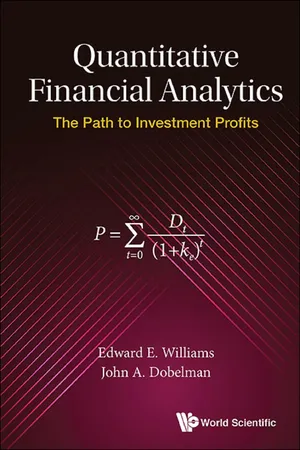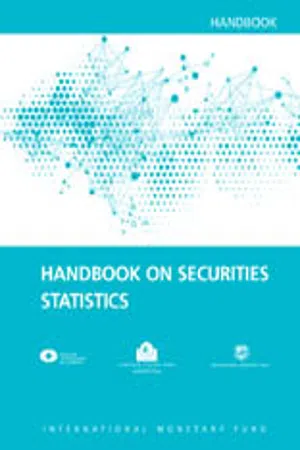Economics
Securities
Securities are financial instruments that represent ownership or debt. They can be traded on financial markets and include stocks, bonds, and derivatives. Securities provide a way for companies and governments to raise capital, and for investors to potentially earn returns on their investments.
Written by Perlego with AI-assistance
Related key terms
3 Key excerpts on "Securities"
- eBook - ePub
Quantitative Financial Analytics
The Path to Investment Profits
- Edward E Williams, John A Dobelman;;;(Authors)
- 2017(Publication Date)
- WSPC(Publisher)
Chapter 3 The Securities Markets and Macroeconomics This [financial] crisis. . . has turned out to be much broader than anything I could have imagined. . . Alan Greenspan, October 23, 2008 The Securities Markets Negotiable financial assets are traded in the money and capital markets. The distinction between the two is based upon the maturity of the financial asset under consideration. The money market is generally defined as consisting of negotiable Securities with a maturity of one year or less; the capital market is composed of the longer-term Securities (including equities, which have a theoretically perpetual life). The distinction, however, is generally more significant than the mere artificial division at the one-year maturity level. The instruments of the money market, aside from being less than a year in maturity, are also generally of high investment quality and are purchased as a means of obtaining some return on temporarily idle funds; in other words, the money market is a market in near-money instruments where safety of principal and liquidity are the primary considerations. The capital market, on the other hand, not only includes Securities of all degrees of risk but also tends to be utilized by investors with funds to be committed for substantial periods. Finally, long-term debt Securities constitute a portion of the capital market at the time of their issuance, but as they approach maturity they become money-market instruments. We shall begin the discussion with the more traditional money-market instruments, which, in the context of this book, may be viewed as possible interest-earning cash substitutes in the investment portfolio. Securities of the U.S. government The U.S. treasury bill is one of the most significant money market instruments. This short-term U.S. government obligation is offered in 28-, 91-, and 182-day maturities. Bills do not carry an interest coupon but are sold at less than their face value - P. C. G. Vassiliou(Author)
- 2013(Publication Date)
- Wiley-ISTE(Publisher)
Chapter 2An Introduction to Financial Instruments and Derivatives
2.1. Introduction
The construction of stochastic models for the pricing of financial instruments, especially in continuous time, often involves very sophisticated stochastic and mathematical concepts. However, the economic insights needed to do so are, in fact, simple and transparent, if one takes the time and energy to clarify them in a rigorous and simple way, doing away with the traditional jargon that one usually comes across. In this chapter, we will try to briefly do so since our emphasis in the book is on the stochastic models involved and not institutional considerations. For the latter there are many excellent books such as Hull (2008), Cox and Rubinstein (1985) and Jarrow and Turnbull (2000).A derivative security is a financial contract whose value is derived from the value of an underlying asset, hence the name. The underlying asset could be any raw material of importance to an economy such as wheat, petrol, salt, metals, or any industrial product. Also, the underlying asset all too often is a financial instrument such as a bond, foreign currency, or even another derivative security. Derivative Securities may be grouped into the following broad headings: options, forward and futures and swaps . We will not attempt to survey the range of derivative Securities now traded in the financial markets, but we will instead concentrate on the more basic options in attempt to create a basic knowledge which the reader will be able to expand conveniently.The basic players in the everyday exchange of financial instruments and assets are: (a) individuals , whose everyday need for consumption and investment is one of the driving forces for the evolution of the entire financial world; (b) corporations who own or have a need of, raw materials, land, and machines and manage manufacturing to meet demand. To raise funds for their growth, corporations all too often issue bonds and stocks. In this respect, corporate management is constrained and directed toward meeting the interests of shareholders and bondholders; (c) intermediaries , such as banks, investment companies, insurance companies, stock exchanges, option and future exchanges, etc.; (d) financial markets- eBook - ePub
- Jose Cartas, and Qi He(Authors)
- 2015(Publication Date)
- INTERNATIONAL MONETARY FUND(Publisher)
3. Financial Instruments Classified as Securities
3.1 This chapter describes the different financial instruments that are classified as debt and equity Securities, respectively. It also considers borderline cases and lists the financial instruments that are not classified as Securities.Passage contains an image
Debt Securities
3.2 The most common types of debt security include bills, bonds, notes, negotiable certificates of deposit, commercial paper, debentures, asset-backed Securities, and similar instruments normally traded in the financial markets that serve as evidence of a debt.3.3 Common types of debt security are those sold on:- A coupon basis , stipulating that periodic interest, or coupon payments will be made during the life of the instrument and that the principal will be repaid at maturity.
- An amortized basis , stipulating that interest and principal payments will be made in installments during the life of the instrument.
- A discount , or zero coupon basis, whereby a debt security is issued at a price that is less than its face (or par) value, and the interest and principal are paid at maturity.
- A deep discount basis , whereby a debt security is issued at a price that is less than face value, and the principal and a substantial part of the interest are paid at maturity.
- An indexed basis , which ties the amount of interest and/or principal payment to a reference index, such as a price index or an exchange rate index, or to the price of a commodity (e.g., gold).
Bills
3.4
Index pages curate the most relevant extracts from our library of academic textbooks. They’ve been created using an in-house natural language model (NLM), each adding context and meaning to key research topics.


